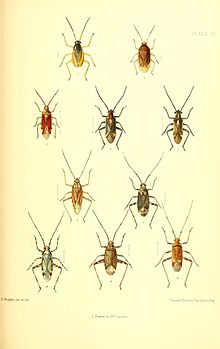Phytocoris populi
- View a machine-translated version of the German article.
- Machine translation, like DeepL or Google Translate, is a useful starting point for translations, but translators must revise errors as necessary and confirm that the translation is accurate, rather than simply copy-pasting machine-translated text into the English Wikipedia.
- Do not translate text that appears unreliable or low-quality. If possible, verify the text with references provided in the foreign-language article.
- You must provide copyright attribution in the edit summary accompanying your translation by providing an interlanguage link to the source of your translation. A model attribution edit summary is
Content in this edit is translated from the existing German Wikipedia article at [[:de:Phytocoris populi]]; see its history for attribution. - You may also add the template
{{Translated|de|Phytocoris populi}}to the talk page. - For more guidance, see Wikipedia:Translation.
| Phytocoris populi | |
|---|---|
 | |
| Phytocoris populi depicted in Edward Saunders Hemiptera Heteroptera of the British Islands (figure 7) | |
| Scientific classification | |
| Domain: | Eukaryota |
| Kingdom: | Animalia |
| Phylum: | Arthropoda |
| Class: | Insecta |
| Order: | Hemiptera |
| Suborder: | Heteroptera |
| Family: | Miridae |
| Genus: | Phytocoris |
| Species: | P. populi |
| Binomial name | |
| Phytocoris populi (Linnaeus, 1758) | |
Phytocoris populi is a species of plant bugs belonging to the family Miridae, subfamily Mirinae.[1] It is widespread in Europe but absent from Albania, Andorra, Azores, Canary Islands, Cyprus, Faroe Islands and Iceland.[2] then across the Palearctic to the Russian Far East and Siberia.
Phytocoris populi lives on various deciduous trees, especially on poplars ( Populus ) and willows (Salix ), more rarely on linden trees ( Tilia ), birches ( Betula ), alders ( Alnus ), ash trees ( Fraxinus ) or fruit trees. Both the nymphs and the imagines sit during the day predominantly in cracks of the bark on the trunk of the host plants. They feed predominantly as predators on aphids , psyllids, Psocoptera and other small invertebrates that live on the trunk of the plants. The adult bugs can be observed from July to September. They are very active in flight.
References
- ^ Kerzhner I. M.; Josifov M. (1999). "Family Miridae". In Aukema, Berend; Rieger, Christian (eds.). Catalogue of the Heteroptera of the Palaearctic Region. Vol. 3, Cimicomorpha II. Amsterdam: Netherlands Entomological Society. pp. 1–577, pages 156–160. ISBN 978-90-71912-19-1.
- ^ "Phytocoris (Phytocoris) populi (Linnaeus, 1758)". 2.6.2. Fauna Europaea. August 29, 2013. Archived from the original on October 14, 2013. Retrieved October 13, 2013.
- v
- t
- e












